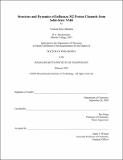| dc.contributor.advisor | Mei Hong. | en_US |
| dc.contributor.author | Mandala, Venkata Shiva. | en_US |
| dc.contributor.other | Massachusetts Institute of Technology. Department of Chemistry. | en_US |
| dc.date.accessioned | 2021-05-25T18:20:25Z | |
| dc.date.available | 2021-05-25T18:20:25Z | |
| dc.date.copyright | 2021 | en_US |
| dc.date.issued | 2021 | en_US |
| dc.identifier.uri | https://hdl.handle.net/1721.1/130804 | |
| dc.description | Thesis: Ph. D., Massachusetts Institute of Technology, Department of Chemistry, February, 2021 | en_US |
| dc.description | Cataloged from the official PDF of thesis. | en_US |
| dc.description | Includes bibliographical references. | en_US |
| dc.description.abstract | The A and B strains of influenza virus places a substantial burden on health, causing around 30 million illnesses, several hundred thousand hospitalizations, and a few tens of thousands of deaths every year in the United States alone. Developing novel antiviral and vaccines against influenza requires understanding the proteins employed by these infectious virions. The matrix-2 protein (M2) is an essential viral protein that conducts protons in the endosomes of infected host cells and induces membrane curvature to facilitate virus budding. M2's proton channel activity is encapsulated by a transmembrane domain (TM) that is targeted by the FDA-approved antiviral drugs amantadine and rimantadine to inhibit viral replication. Proton conduction by M2's TM is mediated by a His-xxx-Trp motif conserved in the otherwise disparate M2 from influenza A (AM2) and influenza B (BM2) strains. | en_US |
| dc.description.abstract | The histidine selects for protons and activates the channel at low pH, while the tryptophan is responsible for gating and unidirectional conduction from the N-terminus (outside) to the C-terminus (inside). M2 conducts protons across lipid bilayers at a moderate rate of ca. 10-1000 s⁻¹. AM2 is well characterized and several high-resolution structures in a variety of membrane and membrane-mimetic environments are available, yet the mechanism of gating and the rate-limiting step of proton conduction are unknown. A gating-deficient mutant was utilized to determine that asymmetric conduction in AM2 is due to tryptophan blocking activation of histidine from the C-terminal side under low pH. Further, in phospholipid bilayers, AM2 shows two discrete conformations that interconvert on the proton conduction timescale, providing the first experimental evidence for a transporter-like mechanism. | en_US |
| dc.description.abstract | In contrast to AM2, BM2 is relatively poorly studied and no high-resolution structures in membranes is available. BM2 shares little sequence homology with AM2, is not inhibited by the antiviral drugs targeting influenza, and conducts protons faster but more bidirectionally than AM2. The first high-resolution structures of membrane-embedded BM2 in the closed and open states are reported. In contrast to the transporter-like motion of AM2, BM2 undergoes a subtler channel-like scissor opening motion, that allows for more efficient proton conduction at the expense of some bidirectional current. | en_US |
| dc.description.statementofresponsibility | by Venkata Shiva Mandala. | en_US |
| dc.format.extent | 229 pages | en_US |
| dc.language.iso | eng | en_US |
| dc.publisher | Massachusetts Institute of Technology | en_US |
| dc.rights | MIT theses may be protected by copyright. Please reuse MIT thesis content according to the MIT Libraries Permissions Policy, which is available through the URL provided. | en_US |
| dc.rights.uri | http://dspace.mit.edu/handle/1721.1/7582 | en_US |
| dc.subject | Chemistry. | en_US |
| dc.title | Structure and dynamics of influenza M2 proton channels from solid-state NMR | en_US |
| dc.type | Thesis | en_US |
| dc.description.degree | Ph. D. | en_US |
| dc.contributor.department | Massachusetts Institute of Technology. Department of Chemistry | en_US |
| dc.identifier.oclc | 1252627286 | en_US |
| dc.description.collection | Ph.D. Massachusetts Institute of Technology, Department of Chemistry | en_US |
| dspace.imported | 2021-05-25T18:20:25Z | en_US |
| mit.thesis.degree | Doctoral | en_US |
| mit.thesis.department | Chem | en_US |
